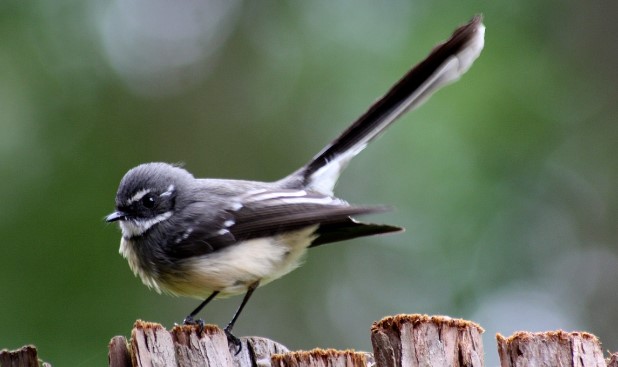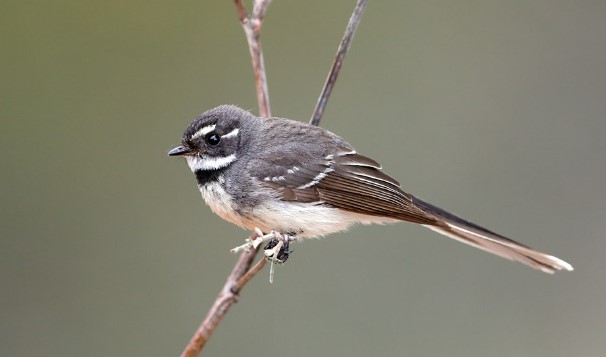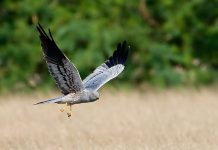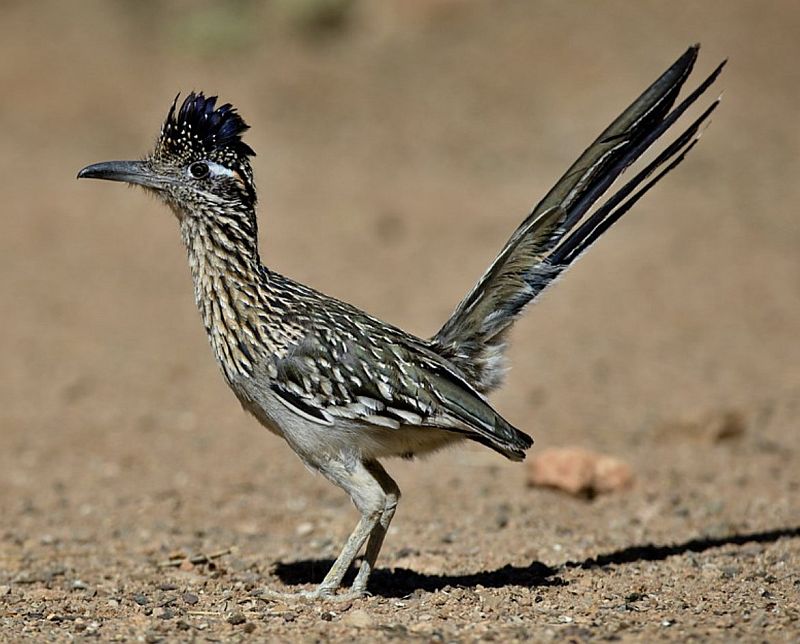Family: The Grey Fantail (Rhipidura fuliginosa) belongs to the family Rhipiduridae
Behavior & Habitats: A Grey Fantail forages through the open mid-strata of forests and woodlands of all kinds. Grey Fantails are known colloquially as ‘Mad Fans’ and ‘Cranky Fans’ because they fly back and forth in every direction.
During their tortuous flights, birds take off from set perches and fly for up to 50 meters before landing again. In comparison with other Australian fantails, grey fantails are more continuously active and more aerial in their feeding, catching flying insects in midair.
Most of the time, they hover over the foliage, not going to the ground. While their vertical range in forest strata overlaps that of the Rufous Fantail, they spread more evenly over a wider range, 20 meters or higher, when they work alone or in loose pairs or groups. There are five races of Grey Fantails in Australia, each feeding actively, but their seasonal movements differ greatly.
Call & Song: The Grey Fantail’s call is sharp, single, or double-chipped in all seasons, by both sexes. Grey Fantail’s song is usually a series of eight to ten short notes with a twangy whistled quality, and it is high-pitched and squeaky.
Similar Species: Numerous experts consider the species conspecific with the New Zealand fantail (Rhipidura fuliginosa). Some authorities treat it separately, however, because of the differences in its calls.
Feeding Habits: An insectivorous bird consumes its prey as it captures it, but larger items are shaken and wiped out before being swallowed. It flutters and hops through open foliage of tall shrubbery occasionally during prolonged periods of hawking. Spiraling up and down tree trunks and zigzagging along branches, picking up small insects as they go, these birds have wings drooped and tails fanned out.
Related Reading: Rufous Fantail (Rhipidura rufifrons)
Distribution: The Grey Fantail can be found in taller woodlands and open forests throughout Australia, as well as in rainforests in northeastern Queensland. Also found in the islands of the southwestern Pacific. Australia has five races; there are about ten worldwide. Atherton and Eungella rainforest tablelands in Queensland, which have very dark forms, are sedentary, while Tasmania has moderately dark forms, which migrate to the southeastern mainland during the winter months. White-tailed races of the central arid zone are more erratically nomadic, while tiny-billed races of the southwest move consistently north and east in winter, but rarely more than 500 kilometers. After nesting, the intermediate race across the southeast disperses far, with some birds making their way to Cape York Peninsula, Arnhem Land, and the Kimberleys in winter.
Alternative Names: The bird is also known as White-shafted Fantail, Cranky Fan, Fanny, and Mad Fan.
Size: Grey Fantails measure approximately 150-160 mm in length.
Identification: There is no difference between the sexes when it comes to adults. The upper parts are plain dark grey to blackish grey. There are two white bars on the wing covers and the inner secondaries of the wings are edged with white; tail feathers are tapered, and the outer five pairs are broadly edged and tipped with white. There is a white stripe behind the eye and a narrow white brow on the face. The throat is dull white; the lower throat is marked by a dusky black line. There is a cream-buff hue on the underparts, which fades to white under the tail and gray on the flanks. Black is the color of the eyes. The bill is black in color. Feet are brown-black.
Read More – The Stunning Pink Robin
Immatures: It has a duller color than adults. The back of the bird is washed brown, the head and wings are buffs, and the throat bar is dark gray.
Nest & Breeds: Nesting and breeding take place between August and January. This nest is constructed from a tiny 150 mm cube of fiber that has been smoothed and bound with cobwebs. The lining is made of fine fiber, and the nest is nailed to a thin horizontal fork of a tree that is 1-6 meters above ground level. During nest building, the nest site varies to ensure a sufficient level of security for breeding.
Eggs: The Grey Fantail lays two, sometimes three, or four dull white to cream eggs that are minutely freckled or blotched with brown in the zone. Approximately 16 x 13 mm in size, eggs are long-oval in shape. Approximately 13-14 days are required for incubation. Additionally, the male bird’s aggression could deter the female, resulting in delayed ovulation, which would allow the male to mate again.
Read More – Hooded Robin (Melanodryas cucullata)









